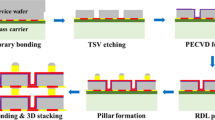Abstract
Manufacturing and integration of MEMS devices by wafer bonding often lead to problems generated by thermal properties of materials. These include alignment shifts, substrate warping and thin film stress. By limiting the thermal processing temperatures, thermal expansion differences between materials can be minimized in order to achieve stress-free, aligned substrates without warpage. Achieving wafer level bonding at low temperature employs a little magic and requires new technology development. The cornerstone of low temperature bonding is plasma activation. The plasma is chosen to compliment existing interface conditions and can result in conductive or insulating interfaces. A wide range of materials including semiconductors, glasses, quartz and even plastics respond favorably to plasma activated bonding. The annealing temperatures required to create permanent bonds are typically ranging from room temperature to 400°C for process times ranging from 15–30 min and up to 2–3 h. This new technique enables integration of various materials combinations coming from different production lines.






Similar content being viewed by others
References
Dragoi V, Glinsner T, Mittendorfer G, Wieder B, Lindner P (2003) Adhesive wafer bonding for MEMS applications. SPIE Proc 5116:160–167
Turner KT, Mlcak R, Roberts DC, Spearing SM (2002) Bonding of bulk piezoelectric material to silicon using a gold-tin eutectic bond. MRS Proc Series 687:B.3.2.1.–B.3.2.6.
Tsau CH, Spearing SM, Schmidt MA (2004) Characterization of Wafer-Level Thermocompression Bonds. J Microelectromech Syst 13(6):963–971
Dragoi V, Lindner P (2006) Plasma activated wafer bonding of silicon: in situ and ex situ processes. ECS Trans 3(6):147–154
Maszara WP, Goetz G, Caviglia A, McKitterick JB (1988) Bonding of silicon wafers for silicon-on-insulator. J Appl Phys 64(10):4943–4950
BCB = Benzocyclobutene. Low-k dielectric material produced by Dow Chemicals (commercial name: Cyclotene) http://www.dow.com/cyclotene/solution/index.htm
Dragoi V, Alexe M, Reiche M, Radu I, Thallner E, Schaefer C, Lindner P (2001) Si/GaAs heterostructures fabricated by direct wafer bonding. MRS Proc Series 681E:I.5.3.1.–I.5.3.6.
Baine PT, Bain M, McNeill DW, Gamble HS, Armstrong BM (2006) Low temperature bonding of PECVD silicon dioxide layers. ECS Trans 3(6):165–173
Mizuno J, Ishida H, Farrens S, Dragoi V, Shinohara H, Suzuki T, Ishizuka M, Glinsner T, Lindner P, Shoji S (2005) Transducers 2005. In: IEEE Proceedings, Seoul, South Korea, p 1346
Lea Di Cioccio (2006) New heterostructures and 3-D devices obtained at CEA/Leti by the bonding and thinning method. ECS Trans 3(6):19–32
Niklaus F, Stemme G, Lu J-Q, Gutmann RJ (2006) Adhesive wafer bonding. J Appl Phys 99:031101-1–031101-28
Author information
Authors and Affiliations
Corresponding author
Rights and permissions
About this article
Cite this article
Dragoi, V., Mittendorfer, G., Thanner, C. et al. Wafer-level plasma activated bonding: new technology for MEMS fabrication. Microsyst Technol 14, 509–515 (2008). https://doi.org/10.1007/s00542-007-0437-7
Received:
Accepted:
Published:
Issue Date:
DOI: https://doi.org/10.1007/s00542-007-0437-7




